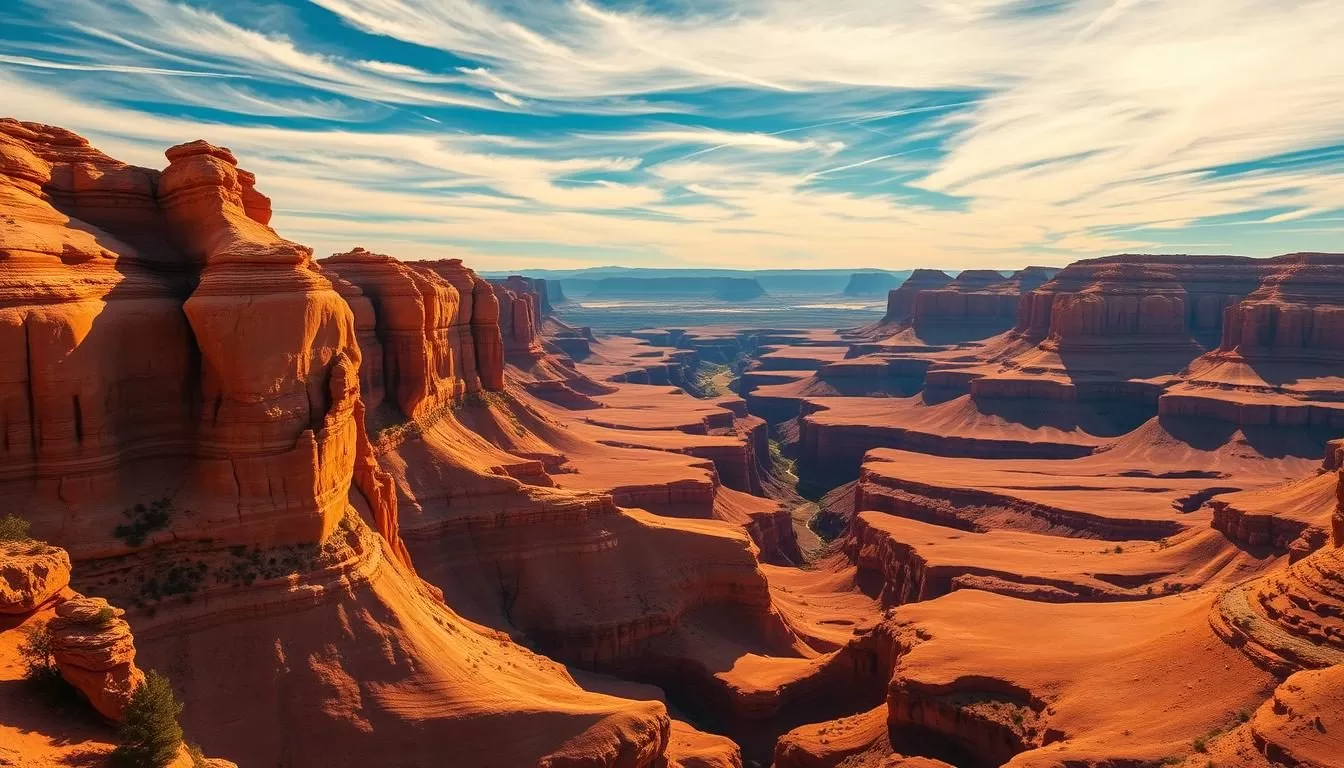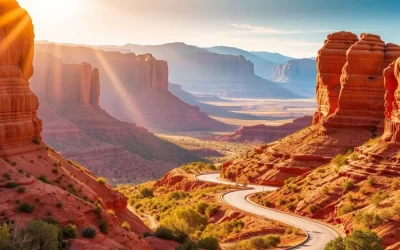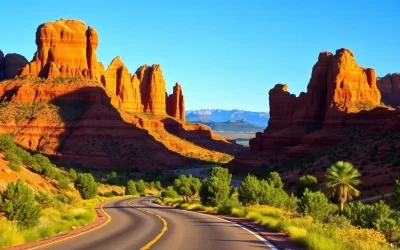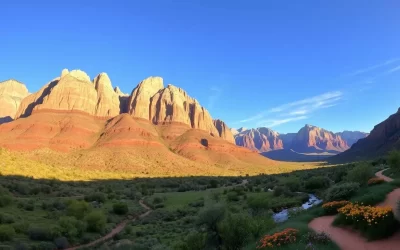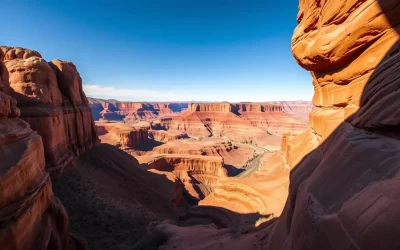Imagine standing amidst breathtaking canyons, mesas, and buttes, carved by the relentless flow of the Colorado and Green Rivers. Welcome to the vast expanse of Canyonlands National Park, the largest national park in Utah, covering an astonishing 337,000 acres.
Unlike its more famous neighbor, Arches National Park, Canyonlands offers a more rugged and less crowded experience, with diverse landscapes across its five distinct districts. You’ll discover spectacular panoramic vistas, ancient rock art, and adventures tailored to every type of visitor, making it one of Utah’s hidden gems.
From scenic drives and hiking trails to off-road adventures and river activities, this comprehensive guide will help you navigate the best things to do in this incredible national park, ensuring your visit is truly memorable.
Discovering Canyonlands National Park
As one of Utah’s most stunning national parks, Canyonlands offers a unique blend of natural beauty and cultural significance. This Canyonlands National Park is a treasure trove of natural wonders, with a rich history that spans thousands of years.
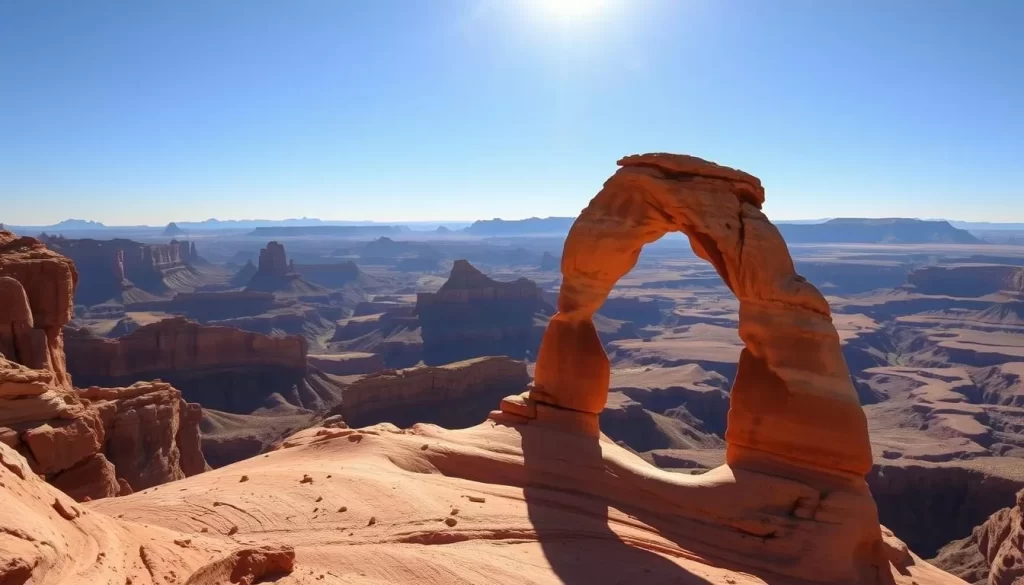
The Hidden Gem of Utah’s National Parks
Canyonlands is often overshadowed by its more famous neighbor, Arches National Park, making it a hidden gem of Utah’s national park system. With fewer crowds but equally stunning landscapes, Canyonlands is an ideal destination for those seeking an unspoiled wilderness experience. The park preserves a vast wilderness of rock at the heart of the Colorado Plateau, featuring countless canyons, mesas, buttes, fins, arches, and spires that showcase millions of years of geological history.
The park’s diverse landscapes make it one best places to experience the natural beauty of the American Southwest. Despite receiving only about 800,000 visitors annually, compared to nearly double that at nearby Arches, Canyonlands offers some of the most spectacular and diverse landscapes in the region.
Brief History of Canyonlands
Canyonlands has a rich and fascinating history that spans thousands of years, with various Native American tribes, including the Ancestral Puebloans, Fremont, and Ute peoples, inhabiting the area for thousands of years. These early inhabitants left behind a rich legacy of rock art, pottery, and other artifacts that can still be seen in the park today.
In the 1800s, the first European explorers began to venture into the area. One of the most famous of these early explorers was John Wesley Powell, who led an expedition down the Green and Colorado Rivers in the late 1800s. Powell was struck by the area’s rugged beauty and recognized its potential as a national park. The area has also been shaped by cattle grazing and uranium mining, with Bates Wilson, known as the “Father of Canyonlands,” working tirelessly to establish the area as a Canyonlands National Park in 1964.
The Five Districts of Canyonlands National Park
Canyonlands National Park is not just a single destination, but a collection of five distinct areas, each offering a unique experience. The park is divided into five districts: Island in the Sky, The Needles, The Maze, Horseshoe Canyon, and The Rivers District. These districts are separated by significant driving distances, ensuring that each visit is a new adventure.
Island in the Sky
The Island in the Sky district is the most accessible and popular area of Canyonlands National Park. Located at the northern end, it sits atop a massive mesa, 1,000 feet above the surrounding terrain. This vantage point offers spectacular panoramic views from numerous overlooks along the paved scenic drive. Visitors can enjoy the breathtaking vistas and take in the natural beauty of the park.

The Needles
Located in the southeastern part of the park, The Needles district is known for its colorful sandstone spires and tall rock formations. The landscape is perfect for hiking and photography, with many trails and viewpoints to explore. The Needles is a bit more challenging to access, requiring a 1.5-hour drive from Moab, but the scenery makes it well worth the trip.
The Maze
The Maze district is the most remote and rugged area of Canyonlands National Park. Located in the western part of the park, it requires a high-clearance, four-wheel-drive vehicle to navigate. This district is ideal for adventurous visitors seeking solitude and untouched natural beauty. The rugged terrain and lack of infrastructure make it a true wilderness experience.
Horseshoe Canyon
Horseshoe Canyon is a detached unit of the park, known for its stunning rock art. The canyon is home to some of the most well-preserved examples of ancient rock art in North America, including the famous Great Gallery with its life-sized anthropomorphic figures. Visitors can hike to the canyon and experience the rich cultural heritage of the area.
The Rivers District
The Rivers District encompasses the Colorado River and Green River, which carved the magnificent canyons of the park. This district offers opportunities for flat water paddling above The Confluence and thrilling whitewater rafting through Cataract Canyon below it. The Rivers District is a paradise for water sports enthusiasts and those looking to explore the park from a different perspective.
Spectacular Sunrise at Mesa Arch
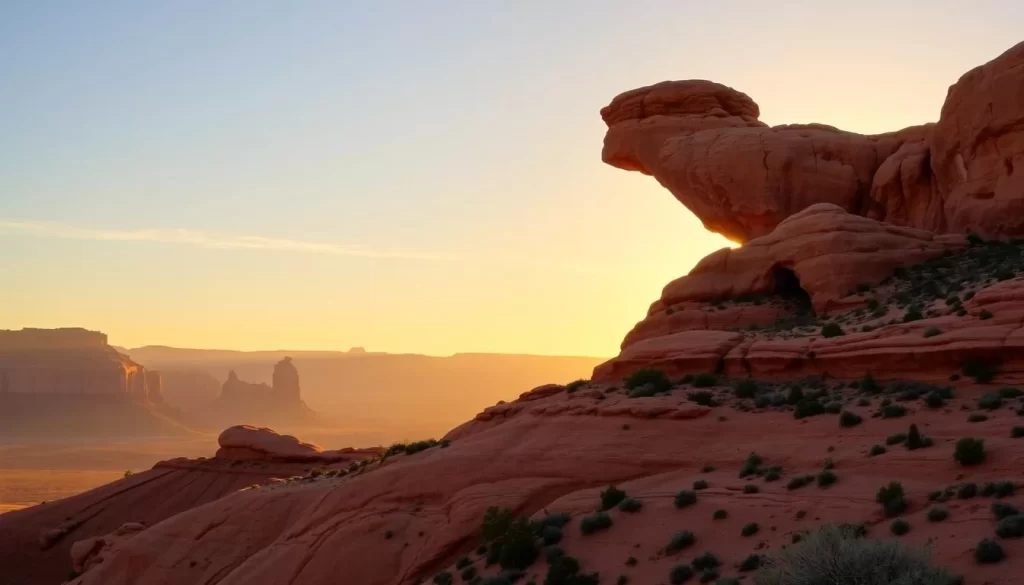
Witnessing the sunrise at Mesa Arch in Canyonlands National Park is an experience like no other. The early morning hours bring a serene atmosphere, with the rising sun casting a golden glow on the underside of the arch.
Mesa Arch, located in the Island in the Sky district, is one of the most photographed sights in the park. It’s a short, easy walk to the arch, with a 0.5-mile round-trip trail that’s accessible to visitors of all ages and abilities.
Getting to Mesa Arch
To experience the breathtaking sunrise at Mesa Arch, plan to arrive at least 45-60 minutes before sunrise. This popular spot attracts many photographers, so securing a good spot early is crucial.
The trail to Mesa Arch is straightforward and easy to navigate, making it suitable for families and individuals with varying mobility levels.
Photography Tips for Mesa Arch
For capturing the best moments at Mesa Arch, consider bringing a wide-angle lens to encompass both the arch and the expansive canyon views. A tripod will help stabilize your camera in low light conditions, and a graduated neutral density filter can balance the bright sky with the darker foreground.
The unique lighting effect at sunrise, where the sun illuminates the underside of the arch, lasts for approximately one hour. Even if you arrive a bit late, you can still capture a stunning photograph.
Visiting Mesa Arch at sunrise is just the beginning. The arch is worth visiting at other times of day as well, offering different lighting conditions and fewer crowds.
Exploring the Island in the Sky Overlooks
As you stand on the edge of the Island in the Sky mesa, the breathtaking views of Canyonlands National Park unfold before you. The Island in the Sky district is a highlight of the park, offering numerous overlooks with spectacular panoramic views.
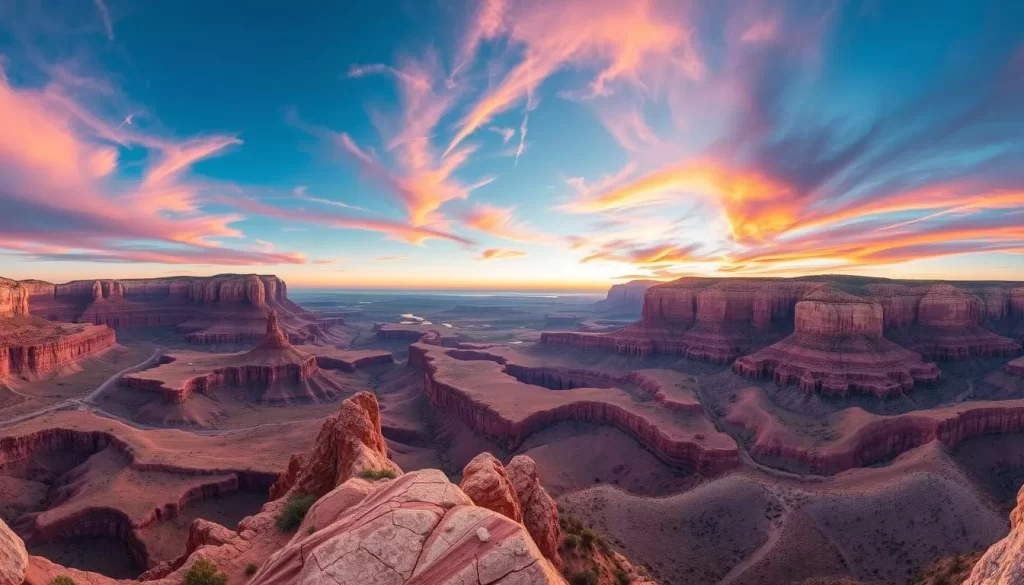
Grand View Point
At the southernmost tip of the Island in the Sky mesa, Grand View Point provides a breathtaking 360-degree panorama. On a clear day, you can see up to 100 miles, taking in the Needles district, the Maze, and the confluence of the Green and Colorado Rivers.
Green River Overlook
The Green River Overlook is another must-visit viewpoint, offering stunning views of the Green River 1,300 feet below, as well as the White Rim, Candlestick Tower, and the Orange Cliffs. It’s an ideal spot to watch the sunset.
Buck Canyon Overlook
For a different perspective, head to Buck Canyon Overlook, where you can gaze down into a vast canyon with views of the La Sal Mountains in the distance. This viewpoint typically has fewer crowds, making it a peaceful experience.
Shafer Canyon Viewpoint
Shafer Canyon Viewpoint provides dramatic views of the famous Shafer Trail switchbacks, which descend 1,400 feet from the mesa top to the White Rim Road below. It’s a glimpse into the adventurous backcountry driving routes within the park.
The Island in the Sky mesa, standing 1,000 feet above the surrounding terrain, offers some of the most spectacular views in Canyonlands National Park. The numerous overlooks along the 20-mile scenic drive make it a paradise for photographers and nature lovers alike.
Best Short Hikes in Island in the Sky
For those who want to experience the beauty of Canyonlands without committing to a full-day hike, the Island in the Sky district has several short and accessible trails. These hikes offer a glimpse into the park’s diverse landscapes and are perfect for visitors of all ages and skill levels.
White Rim Overlook Trail
The White Rim Overlook Trail is a relatively easy 1.8-mile round-trip hike that rewards you with spectacular panoramic views of Monument Basin, the Colorado River, and the La Sal Mountains in the distance. This trail is perfect for both sunrise and sunset photography, making it a great alternative to the more crowded Mesa Arch Trail.
As you hike, you’ll notice the unique geological formations that have been shaped by millions of years of erosion. The trailhead is easily accessible, and the moderate elevation gain makes it suitable for families and casual hikers.
Upheaval Dome Trail
The Upheaval Dome Trail offers two overlook points, with the first being a 0.8-mile round-trip and the second a 1.8-mile round-trip. This trail takes you to a mysterious geological feature that scientists debate was either formed by a meteorite impact or a salt dome collapse. The views from the overlooks are breathtaking, with the crater’s unique landscape unfolding before you.
The trail features some slickrock sections and moderate elevation gain, so proper footwear with good traction is recommended. The geological formations along the trail are fascinating, with visible layers of rock telling the story of the region’s complex geological history.
Whale Rock Trail
The Whale Rock Trail is a fun 1-mile round-trip hike that takes you up a large sandstone dome resembling a whale. The panoramic views from the top are stunning, with 360-degree vistas of the surrounding landscape, including Upheaval Dome. This trail is one of the best short hikes for families, as it’s relatively easy and offers an educational experience about the park’s geology.
The trail involves some slickrock hiking and moderate elevation gain, so it’s essential to wear proper footwear. The views from Whale Rock are particularly spectacular during sunrise or sunset, when the changing light casts a golden glow over the landscape.
| Trail Name | Distance (Round-Trip) | Notable Features |
|---|---|---|
| White Rim Overlook Trail | 1.8 miles | Panoramic views of Monument Basin and the Colorado River |
| Upheaval Dome Trail | 0.8 or 1.8 miles | Mysterious geological crater, unique rock formations |
| Whale Rock Trail | 1 mile | 360-degree views, whale-shaped sandstone dome |
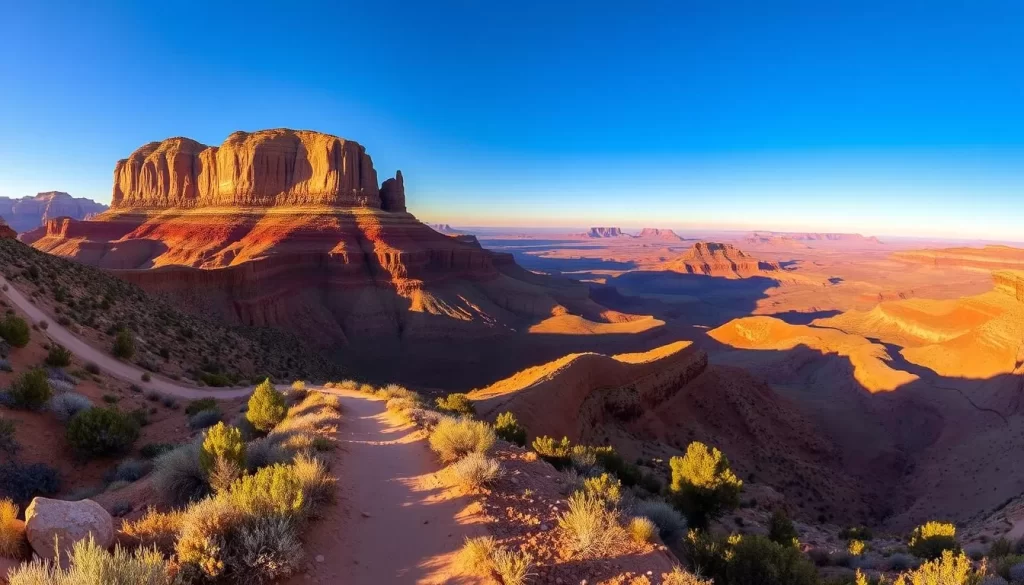
Adventurous Hikes Below the Rim
If you’re looking for a true adventure, consider hiking below the rim in Canyonlands National Park’s Island in the Sky district. These hikes offer a unique perspective on the park’s vast and varied landscapes.
The Island in the Sky mesa tops are just the beginning. For adventurous hikers, Canyonlands offers several challenging trails that descend approximately 1,400 feet to the White Rim level. This dramatic change in elevation not only provides a different perspective but also allows hikers to experience the park’s diverse geological layers up close.
Gooseberry Trail
The Gooseberry Trail is a 5.4-mile round-trip hike known for being one of the steepest in Canyonlands National Park. Starting near the White Rim Overlook, it descends steeply down to the White Rim Road, offering spectacular views of Gooseberry Canyon.
Murphy Trail Loop
For a more extensive adventure, the Murphy Trail Loop covers 10.8 miles, descending from the Island in the Sky mesa near Grand View Point and climbing back up through Murphy Wash. This loop is considered one of the most scenic below-the-rim adventures.
Syncline Loop
The Syncline Loop is an 8.5-mile challenging hike that circles Upheaval Dome. It’s considered the most challenging day hike in the Island in the Sky district and requires good route-finding skills and excellent physical conditioning.

| Trail Name | Distance (miles) | Difficulty Level |
|---|---|---|
| Gooseberry Trail | 5.4 | Strenuous |
| Murphy Trail Loop | 10.8 | Very Strenuous |
| Syncline Loop | 8.5 | Extremely Strenuous |
These below-the-rim hikes in Island in the Sky offer solitude and perspectives that most visitors to Canyonlands National Park never experience. However, they require careful planning, early starts, plenty of water, and appropriate hiking gear.
By undertaking these hikes, you’re not only experiencing one of the best things to do in Canyonlands but also gaining a deeper understanding of the park’s geological history and natural beauty.
The White Rim Road Adventure
Embark on the White Rim Road, one of the most epic adventures in Canyonlands National Park, and experience the raw beauty of the Island in the Sky mesa.
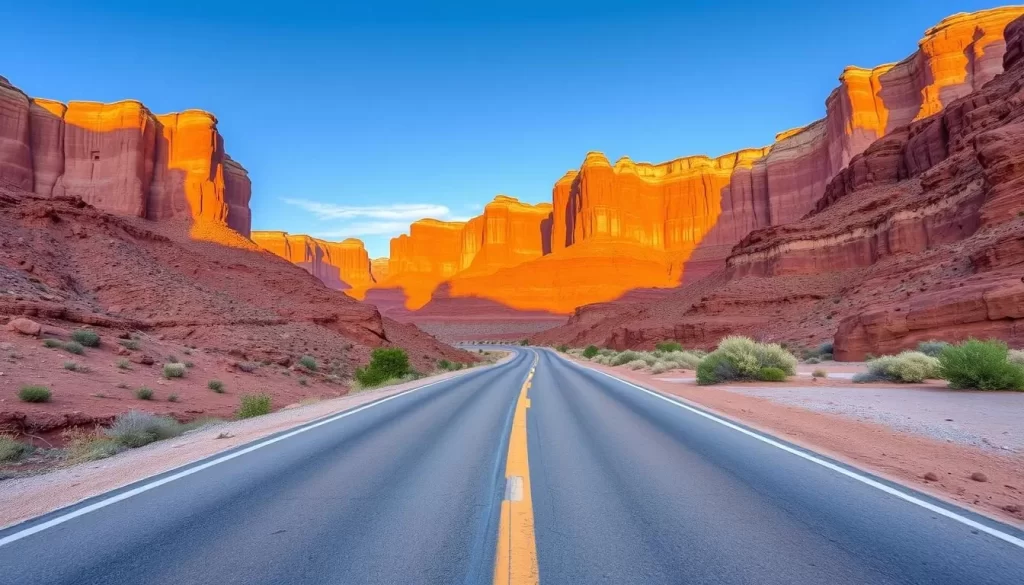
The White Rim Road is a 100-mile dirt road that makes a loop around the Island in the Sky mesa, offering an unforgettable experience for those seeking adventure and solitude in Canyonlands National Park. There are several ways to experience this adventure, including driving the full loop, biking, or taking part in the road as a day trip.
Planning Your White Rim Road Trip
Planning is essential for this adventure. You’ll need a high-clearance 4WD vehicle to navigate the challenging route, which includes steep switchbacks, loose rock sections, and potential washouts. Permits are required for both day use and overnight trips, with camping permits becoming available four months in advance.
For the ultimate experience, drive the full 100-mile loop, which typically takes 2 to 3 days, camping along the route. This allows you to slow down, drive detours, hike a trail or two, and enjoy the night sky.
Highlights Along the White Rim Road
The White Rim Road offers numerous highlights, including the dramatic Shafer Trail switchbacks, Musselman Arch, White Crack with views of The Maze district, Monument Basin’s towering spires, and Hardscrabble Hill’s challenging ascent. For those short on time, you can experience portions of the White Rim Road as day trips.
The road conditions can be affected by weather, with summer bringing extreme heat and flash flood risks, while winter and spring can make sections impassable. Thus, spring and fall are the ideal seasons for this adventure.
Canyonlands National Park, Utah: Best Things to Do in The Needles District
The Needles District, with its unique landscape, provides an unforgettable experience for visitors to Canyonlands National Park. Located in the southeastern corner of the park, this district is characterized by its stunning sandstone formations, making it an ideal location for hiking, photography, and backcountry exploration.
Chesler Park Loop Trail
The Chesler Park Loop Trail is considered the crown jewel of The Needles District, offering an 11-mile adventure through diverse landscapes, including sandstone spires, grassy meadows, and the famous Joint Trail slot canyon. This hike, which takes around 5 to 7 hours to complete, provides constantly changing scenery. For those with limited time, a shorter 6-mile out-and-back hike to the Chesler Park viewpoint is available, still offering spectacular views of the colorful needles formations.
Slickrock Trail
The Slickrock Trail, a 2.4-mile loop, is an underrated hike that offers panoramic views of the Needles formations, the La Sal Mountains, and the Island in the Sky mesa. Most hikers miss the best viewpoints by turning back too soon, so it’s recommended to complete the full loop for the best experience.
Cave Spring Trail
The Cave Spring Trail is a short, 0.6-mile loop that provides a fascinating glimpse into the area’s ranching history. The trail features a natural spring, a preserved cowboy camp with authentic artifacts, prehistoric pictographs, and two fun ladder climbs leading to panoramic views. This trail is an excellent choice for those looking to learn about the region’s history without committing to a long hike.
| Trail Name | Distance | Duration | Highlights |
|---|---|---|---|
| Chesler Park Loop Trail | 11 miles | 5-7 hours | Sandstone spires, grassy meadows, Joint Trail slot canyon |
| Slickrock Trail | 2.4 miles | 1-2 hours | Panoramic views of Needles formations, La Sal Mountains |
| Cave Spring Trail | 0.6 miles | 30 minutes | Natural spring, preserved cowboy camp, prehistoric pictographs |
While The Needles District requires a longer drive from Moab, approximately 1.5 hours, the unique landscapes and significantly smaller crowds make it well worth the journey for those seeking to experience a different side of Canyonlands National Park.
Exploring The Maze: For the Adventurous
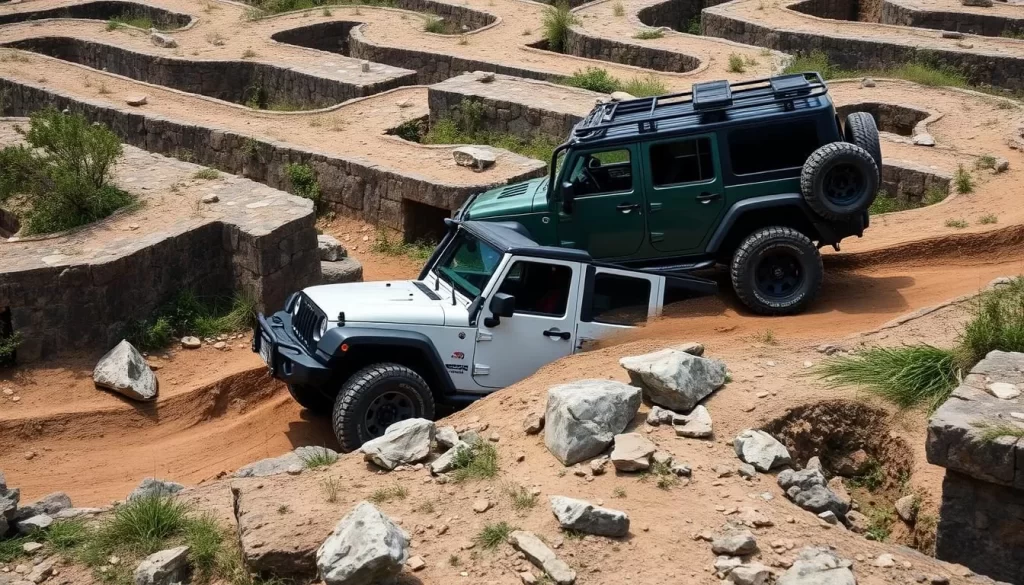
Canyonlands National Park’s The Maze district is a challenging yet rewarding destination for those with a thirst for adventure. As the most remote and inaccessible area of the park, it promises an unforgettable experience for seasoned travelers.
The Maze is characterized by its complex network of canyons and rugged landscape, making it a true test of adventure and self-sufficiency. To explore this vast and breathtaking district, one must be well-prepared.
Requirements for Visiting The Maze
Visiting The Maze demands careful preparation. A high-clearance, four-wheel-drive vehicle is mandatory, as is experience driving on rough terrain. The district’s vastness and the difficulty of its roads mean you’ll need at least 2 to 3 days to explore it thoroughly.
Additionally, for overnight stays, securing a backcountry permit in advance is crucial. The limited number of permits helps preserve the wilderness character of The Maze.
Top Sights in The Maze
The Maze district is home to some of Canyonlands National Park’s most spectacular landscapes. The Land of Standing Rocks and the Chocolate Drops are must-see attractions, with their unique sandstone formations.
Other highlights include the Harvest Scene pictographs, a testament to the area’s rich cultural heritage, and the stunning Orange Cliffs, which offer breathtaking vistas.
Ancient Rock Art at Horseshoe Canyon
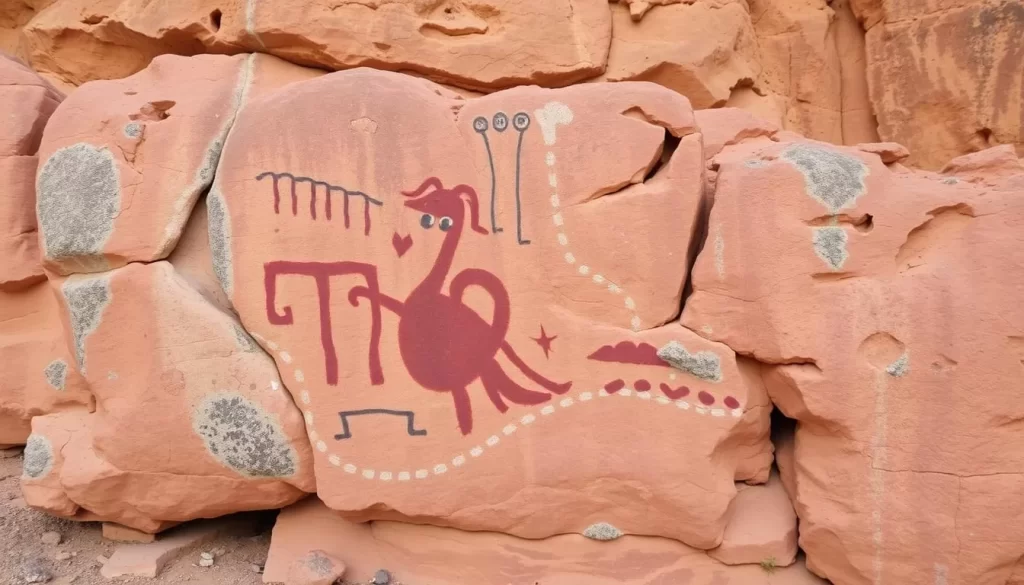
One of the best places to experience ancient rock art in North America is Horseshoe Canyon, located within Canyonlands National Park. This detached unit of the park is a treasure trove of cultural heritage, featuring some of the most significant and well-preserved ancient artwork on the continent.
The Great Gallery
The Great Gallery is the crown jewel of Horseshoe Canyon, boasting a 200-foot long panel adorned with dozens of hauntingly beautiful, life-sized anthropomorphic figures. These ancient artworks, painted in the distinctive “Barrier Canyon Style” or “Archaic Abstract,” are a testament to the rich cultural history of the region. The figures are remarkably well-preserved, with some dating back 2,000 to 4,000 years.
As you approach the Great Gallery, you’ll be struck by the intricate details and the vivid imagery that has survived the test of time. This is truly one of the best experiences you can have in Canyonlands National Park, offering a unique glimpse into the lives of the people who once inhabited this land.
Hiking to Horseshoe Canyon
To reach the Great Gallery, you’ll need to embark on a challenging 7-mile round-trip hike that descends 750 feet into Horseshoe Canyon. The journey takes you through a beautiful desert landscape, complete with cottonwood groves and seasonal streams, and passes several smaller rock art panels along the way.
The hike is strenuous, but the reward is well worth the effort. As you make your way down into the canyon, you’ll be surrounded by the natural beauty of the national park, with the rugged landscape unfolding before your eyes. Be sure to plan your visit carefully, as the trip from Moab takes around 2.5 hours, with 30 to 47 miles of gravel road driving, depending on the route you choose.
Visiting Horseshoe Canyon is a full-day adventure that requires careful planning, but it’s an experience you won’t soon forget. As part of Canyonlands National Park‘s district, it’s a must-see destination for anyone interested in ancient rock art and the natural beauty of this incredible national park.
River Adventures in Canyonlands
River adventures in Canyonlands National Park are a thrilling way to explore the park’s vast landscapes. The park’s unique landscape is shaped by the Colorado River and the Green River, which converge at the Confluence.
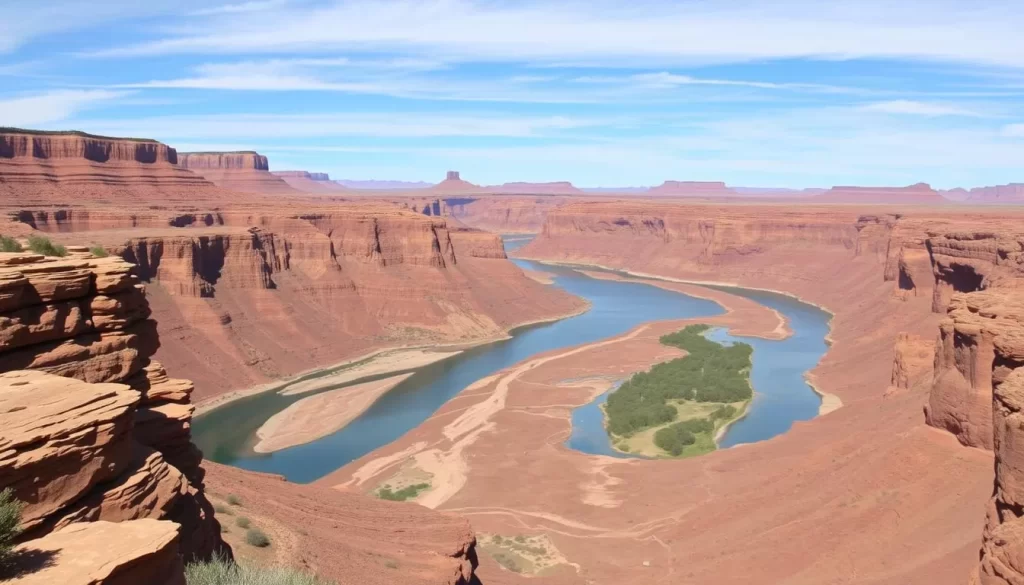
Canoeing and Kayaking Above the Confluence
Above the Confluence, the Green River and Colorado River flow gently, creating perfect conditions for canoeing and kayaking. You can enjoy half-day excursions or multi-day adventures, paddling beneath towering canyon walls and camping on sandy beaches.
The calm waters above the Confluence are ideal for beginners and families. You’ll have the opportunity to spot wildlife along the shorelines while enjoying the serenity of this remote wilderness area.
White Water Rafting in Cataract Canyon
Below the Confluence, the combined forces of the Colorado and Green Rivers create Cataract Canyon, known for its challenging whitewater. You can experience the thrill of white water rafting on Class III to V rapids, guided by professional outfitters who provide all necessary equipment and safety instruction.
The White Rim and surrounding canyon landscapes offer a unique perspective when viewed from the river. You’ll look up at formations you may have previously viewed from above, gaining a more complete understanding of the park’s magnificent scale and beauty.
Stargazing in Canyonlands
Under the dark skies of Canyonlands National Park, the universe unfolds in all its glory. As one of the most remote national parks in the United States, Canyonlands offers an unmatchable stargazing experience.
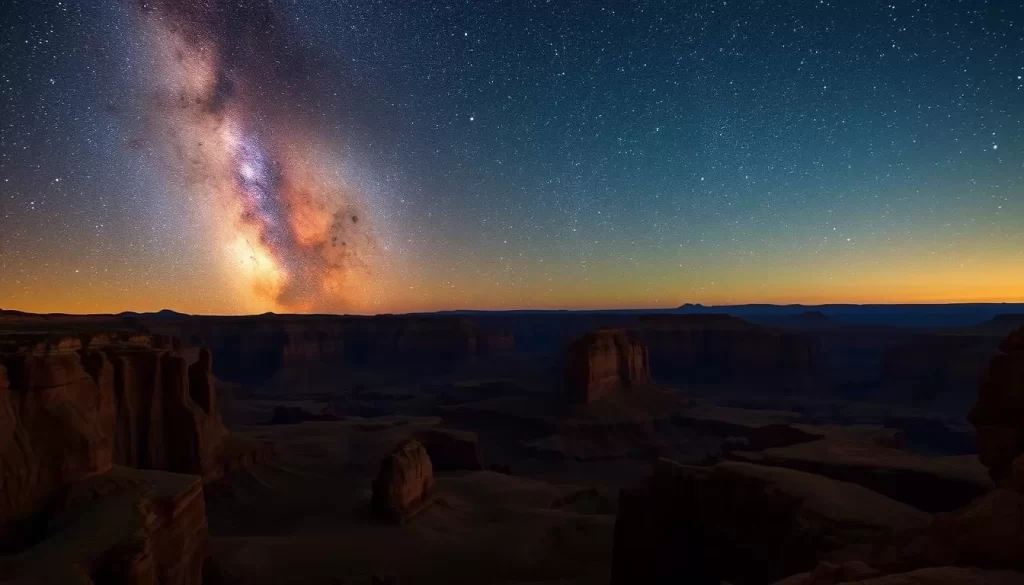
Dark Skies and Celestial Wonders
Canyonlands National Park is designated as an International Dark Sky Park, boasting some of the darkest night skies in the country. On clear nights, the Milky Way stretches dramatically across the sky, and thousands of stars, planets, and distant galaxies are visible to the naked eye.
Best Locations for Stargazing
The Island in the Sky district offers several prime locations for stargazing, including Grand View Point, Green River Overlook, and the Upheaval Dome parking area. In The Needles district, Wooden Shoe Arch Overlook and Big Spring Canyon Overlook provide excellent stargazing opportunities with dramatic foregrounds.
Ranger-Led Night Programs
To enhance your stargazing experience, Canyonlands National Park offers ranger-led night sky programs seasonally. These programs provide telescopes for a closer look at celestial objects and expert insights into astronomy, nocturnal wildlife, and the cultural significance of the night sky.
For the ultimate experience, consider camping in the park or embarking on a White Rim Road trip, where you can witness the progression of stars throughout the night.
When to Visit Canyonlands National Park
Canyonlands National Park is a year-round destination, but the experience varies greatly depending on the time of year you visit. Understanding the seasonal changes and weather conditions can help you plan a more enjoyable trip.
Seasonal Highlights
The park’s diverse landscape and climate mean that each season offers a unique experience. Spring (March to May) is a great time to visit, with mild temperatures and wildflowers in bloom. The seasonal waterfalls and vibrant greenery against the red rock formations create a breathtaking landscape. In the fall (September to November), the cooler temperatures and changing foliage make it an ideal time for hiking and outdoor activities. The golden cottonwood trees along the riverbanks add to the scenic beauty.
During summer (June to August), the park is hot, with temperatures often exceeding 100°F. However, this is a great time for river activities like rafting or kayaking. The sunsets are also particularly stunning during this period. In contrast, winter (December to February) brings cold temperatures and potential snow, but the park’s solitude and the snow-dusted red rocks offer a serene and unique experience.
- Spring and fall are the best times to visit for comfortable hiking and outdoor activities.
- Summer is ideal for river activities despite the heat.
- Winter offers a peaceful and serene experience, with potential snowfall creating stunning photographic opportunities.
Weather Considerations
When planning your visit, it’s essential to consider the weather. The park’s weather can be unpredictable, with sudden changes in temperature and precipitation. During the summer, heat protection and hydration are crucial, while in the winter, warm clothing and appropriate gear for icy conditions are necessary.
Avoid visiting during special events like the Easter Jeep Safari in Moab, as the area can become crowded, and accommodation prices may skyrocket. Understanding these factors will help you plan a more enjoyable and stress-free trip to Canyonlands National Park.
Planning Your Visit to Canyonlands
Planning a visit to Canyonlands National Park requires some preparation to ensure you make the most of your trip. With its vast and diverse landscapes, Canyonlands offers a range of experiences, from scenic drives and hiking trails to river rafting and backcountry exploration.
Park Entrance Fees and Hours
Canyonlands National Park is open 24 hours a day, 365 days a year. The park’s visitor centers have seasonal operating hours, typically from 8am-4:30pm with extended hours during peak season. Entrance fees are $30 per vehicle, valid for seven consecutive days. You can also use an America the Beautiful Annual Pass ($80), which covers entrance to all national parks and federal recreational lands for a year.
Some visitors may qualify for a free annual pass, including those with a fourth grader, veterans, or individuals with disabilities. Seniors can also obtain a lifetime America the Beautiful pass for a one-time purchase.
Required Permits and Reservations
Unlike nearby Arches National Park, which has implemented a timed entry reservation system during peak season, Canyonlands National Park does not require advance reservations for general park entry. However, you will need to obtain permits for certain activities, including backcountry camping, overnight trips on the White Rim Road, river trips, and backcountry vehicle day use on certain roads like Elephant Hill in The Needles district.
It’s essential to plan ahead and secure the necessary permits to avoid any issues during your visit.
What to Pack for Canyonlands
When visiting Canyonlands National Park, it’s crucial to pack the right gear. Essential items include plenty of water (at least one gallon per person per day), sun protection (hat, sunscreen, sunglasses, lightweight long-sleeved clothing), sturdy hiking shoes with good traction, navigation tools (maps, compass, GPS), a first aid kit, and food/snacks.
Being prepared will help ensure a safe and enjoyable experience in the park.
How Many Days to Spend
Ideally, plan to spend at least two full days in Canyonlands National Park to experience both the Island in the Sky and The Needles districts. With additional days, you can explore the White Rim Road, go river rafting, or backpack in The Needles. If you’re combining Canyonlands with a visit to Arches National Park, allow at least 3-4 days in the Moab area to experience the highlights of both parks without feeling rushed.
With this information, you can plan a memorable trip to Canyonlands National Park and enjoy the many wonders it has to offer.
Where to Stay Near Canyonlands
If you’re planning to visit Canyonlands National Park, you’ll want to know about the different lodging options near the park. Since there is no lodging inside Canyonlands National Park, visitors typically stay in nearby areas.
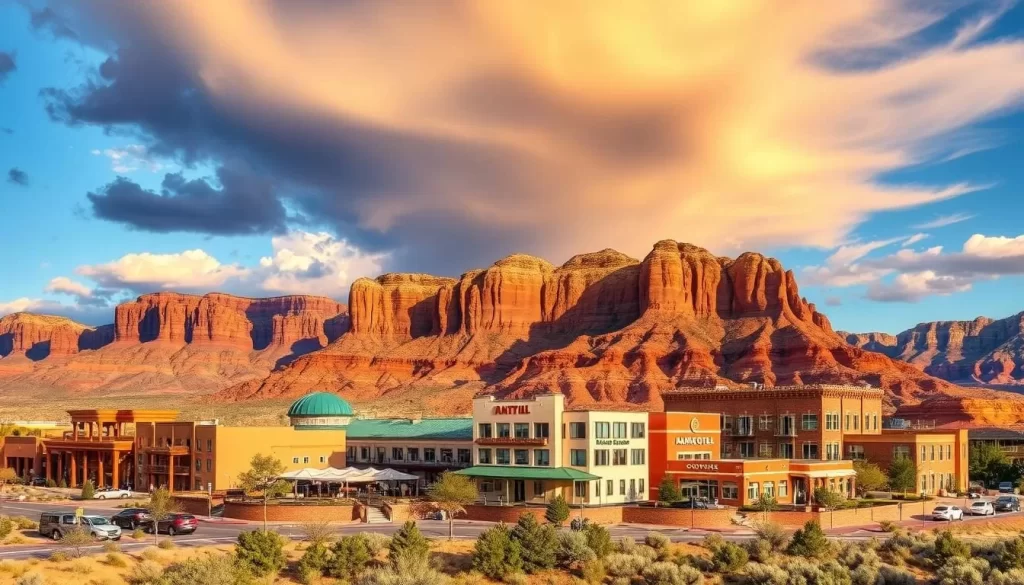
Camping Options in the Park
Canyonlands National Park offers several camping options within its districts. The Willow Flat Campground in the Island in the Sky district has 12 sites that are first-come, first-served, accommodating tents and RVs up to 28 feet in length.
The Needles Campground in the Needles District has 26 sites with picnic tables, fire rings, and flush toilets. Although it’s first-come, first-served, reservations are recommended during peak season.
For larger groups, Canyonlands National Park offers group campsites in both the Island in the Sky and Needles districts, accommodating up to 50 people. Reservations can be made up to six months in advance through recreation.gov.
Accommodations in Moab
The town of Moab is the best place to stay when visiting Canyonlands National Park, offering a wide range of accommodations from luxury resorts to budget motels. You can choose from upscale properties like Hoodoo Moab and Hyatt Place, mid-range options like Homewood Suites, or budget-friendly accommodations like MainStay Suites.
Moab also provides various amenities, including restaurants, grocery stores, and outfitters, making it a convenient base for your trip. Additionally, its proximity to Arches National Park makes it an ideal location for exploring both parks.
Other Nearby Options
If you’re looking for alternatives to Moab, Dead Horse Point State Park offers two campgrounds with electricity and modern amenities, providing stunning views. For those visiting The Needles district, the towns of Monticello and Blanding offer basic accommodations.
The Bureau of Land Management (BLM) lands surrounding Moab also offer dispersed camping opportunities for self-sufficient travelers, providing a more primitive experience at minimal or no cost.
Conclusion: Experience the Wonder of Canyonlands
From the majestic vistas of the Island in the Sky to the ancient rock art of Horseshoe Canyon, Canyonlands National Park is a treasure trove of natural wonders. As you explore this vast and diverse landscape, you’ll discover that each district of the park presents its own unique character and opportunities for adventure.
Whether you’re watching the sunrise illuminate Mesa Arch, hiking among the sandstone formations, driving the rugged White Rim Road, or floating down the Colorado River, the experiences you’ll have in Canyonlands National Park will leave you with lasting memories. The park offers an unparalleled wilderness experience, showcasing the power of natural forces that have shaped our landscape over millions of years.
Unlike more crowded national parks, Canyonlands National Park still offers genuine solitude and adventure for those willing to venture beyond the beaten path. As you plan your visit, remember that the park’s vast size means that even multiple visits can’t exhaust all it has to offer. Canyonlands National Park truly embodies the spirit of the American West—rugged, vast, and infinitely rewarding.
